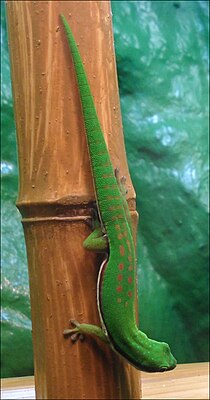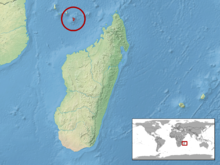Black stripe day gecko
| Black stripe day gecko | ||||||||||||
|---|---|---|---|---|---|---|---|---|---|---|---|---|

Black-striped day gecko ( Phelsuma nigristriata ) |
||||||||||||
| Systematics | ||||||||||||
|
||||||||||||
| Scientific name | ||||||||||||
| Phelsuma nigristriata | ||||||||||||
| Meier , 1984 |
The black-stripe day gecko ( Phelsuma nigristriata ) is a lizard and belongs to the gecko family (Gekkonidae). The species reaches a length of ten to eleven centimeters and is one of the smallest day geckos .
features
It becomes up to 11 cm long, with the head-torso length up to 4.6 cm. The female is usually a bit slimmer than the male, the male has a thicker head and usually stronger colors. The back of the animals is green with red to red-orange spots, the belly is white and is separated from the green back by a black stripe. In the female, in addition to the three small black stripes, there are also small turquoise dots in the neck area.
distribution

This species is endemic to the Comoros island of Mayotte . She usually stays at the edge of the forest, where it is rather humid. It can be found on bamboo , agaves or similar plants and trees. The air humidity is over 80 percent during the day and increases to almost 100 percent at night. The mean annual temperature is around 28 ° C.
Way of life
The eggs are laid on the plants in hollows or leaf axils. However, like its closest relatives within the Phelsuma dubia group, the black stripe day gecko cannot stick these to the plants.
Systematics
The black-stripe day gecko belongs to the Phelsuma dubia group, a clade within the day geckos. Together with Phelsuma modesta it forms a sister group to the other representatives of the clade, these are P. dubia , P. berghofi , P. hielscheri , P. malamakibo , P. flavigularis and P. ravenala .
It was found in 1983 by Harald Meier at Ivambeni on Mayotte and described by him in 1984 . In addition to the black-stripe day gecko, the relatives Phelsuma dubia and Phelsuma laticauda as well as the species Phelsuma robertmertensi, which is also only native to this island, and the subspecies Phelsuma v-nigra pasteuri occur on Mayotte .
The scientific species name nigristriata of this day gecko is derived from the two Latin words niger (for black) and striatus (for striped) and refers to the black stripes in the neck area of the black stripe day gecko.
Terrarium keeping
The establishment of the terrarium should contain as many smooth objects as possible, e.g. B. bamboo cane or plants with large leaves. The animals need hiding places and the opportunity to lay eggs. The terrarium should have different temperature zones between 22 and 32 ° C, at night approx. 18 to 20 ° C. The humidity should be between 50 and 70 percent. In the terrarium, the black-stripe day geckos live to be eight to ten years old. The life expectancy of females is slightly shorter than that of males when kept in a terrarium.
literature
- Harald Meier: Two new forms of the genus Phelsuma from the Comoros (Sauria: Gekkonidae). In: Salamandra. Vol. 20, No. 1, 1984, ISSN 0036-3375 , pp. 32-38, (first description).
- Philippe Gérard: L'élevage des geckos diurnes et des Uroplatus. Philippe Gérard éditions, Paris 1998, ISBN 2-912521-12-2 .
- Herbert Rösler: Annotated list of the recently, subordinate and fossil known Geckotaxa (Reptilia: Gekkonomorpha). In: Gekkota. Vol. 2, 2000, ZDB -ID 2080442-8 , pp. 28-153, here p. 103.
- Richard D. Bartlett, Patricia Bartlett: Day Geckos. Barron's, Hauppauge NY 2001, ISBN 0-7641-1699-1 , p. 19.
- Herbert Rösler: On the rump scaling of the genus Phelsuma GRAY 1825: zoogeographical aspects (Sauria: Gekkonedae). In: Gekkota. Vol. 3, 2001, pp. 47-73.
- Hans-Peter Berghof: Day geckos. The genus Phelsuma. Maintenance and propagation. Natur-und-Tier-Verlag, Münster 2005, ISBN 3-937285-45-8 , p. 81.
- Hans-Peter Berghof: The day geckos of the genus Phelsuma from the Comoros island of Mayotte. In: Draco. Vol. 11, No. 43, 2010, ISSN 1439-8168 , pp. 60-64.
Web links
- Phelsuma nigristriata in The Reptile Database
- Phelsuma nigristriata inthe IUCN Red List of Threatened Species 2013.2. Posted by: Hawlitschek, O. & Glaw, F, 2011. Retrieved January 30, 2014.
Individual evidence
- ↑ Sara Rocha, Herbert Rösler, Philip-Sebastian Gehring, Frank Glaw , David Posada, D. James Harris, Miguel Vences : Phylogenetic systematics of day geckos, genus Phelsuma, based on molecular and morphological data (Squamata: Gekkonidae). In: Zootaxa. 2429, 2010, pp. 1–28, digital version (PDF; 1.46 MB) .
- ↑ Michel Louette, Danny Meirte, Rudy Jocqué (Red.): La faune terrestre de l'archipel des Comores (= Studies in Afrotropical Zoology. No. 293). Musée royal de l'Afrique centrale, Tervuren 2004, ISBN 90-75894-63-5 , p. 19.
- ^ Murray Wrobel: Elsevier's dictionary of reptiles. In Latin, English, German, French and Italian. Elsevier, Amsterdam et al. 2004, ISBN 0-444-51499-6 , pp. 272-273.
